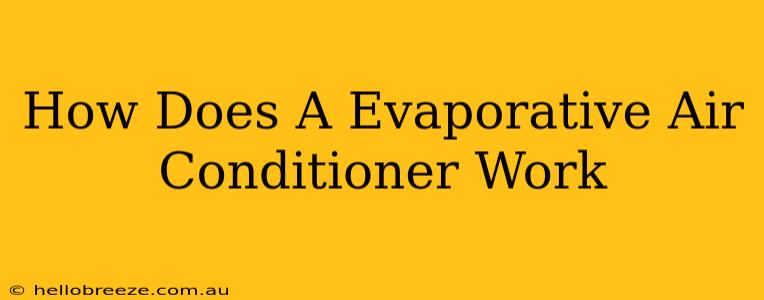Summer heat can be brutal, making finding effective ways to cool your home essential. While traditional air conditioners are popular, evaporative air conditioners (also known as swamp coolers) offer a unique and often more energy-efficient alternative. But how do these devices actually work? Let's dive in and explore the science behind evaporative cooling.
Understanding the Basics of Evaporative Cooling
The core principle behind evaporative air conditioning is simple: water absorbs heat when it evaporates. This is a natural process you've likely experienced – think about how much cooler you feel after getting out of a swimming pool. The same principle is applied on a larger scale within an evaporative air conditioner.
The Process Explained:
-
Water Intake: The system draws water from a reservoir or directly connects to a water source.
-
Water Distribution: This water is then distributed across a pad or filter, usually made of a cellulose material.
-
Air Intake: A fan pulls in hot, dry air from outside.
-
Evaporation: As the hot air passes over the moist filter, the water evaporates. This evaporation process absorbs heat from the air, cooling it significantly.
-
Cooled Air Distribution: The now cooler, more humid air is then blown into your space.
Key Components of an Evaporative Air Conditioner
Several key components work together to make this cooling process effective:
-
Water Pump: Circulates water to keep the cooling pad consistently wet.
-
Cooling Pad (or Filter): A porous material that maximizes surface area for evaporation. Regular cleaning and replacement are crucial for optimal performance.
-
Fan: Powerful enough to draw in sufficient air volume and distribute cooled air effectively throughout your space.
-
Water Reservoir (or Connection): Holds the water supply. Some models connect directly to a water source.
-
Control Panel: Allows you to adjust fan speed and other settings.
Evaporative vs. Traditional Air Conditioning: Key Differences
While both systems aim to cool your home, they differ significantly in their methods:
| Feature | Evaporative Air Conditioner | Traditional Air Conditioner |
|---|---|---|
| Cooling Method | Evaporative cooling (water evaporation) | Refrigerant-based compression cycle |
| Energy Efficiency | Generally more energy-efficient | Typically less energy-efficient |
| Humidity | Increases humidity | Decreases humidity |
| Climate Suitability | Best suited for hot, dry climates | Effective in various climates |
| Cost | Typically less expensive to purchase and operate | More expensive to purchase and operate |
When Are Evaporative Air Conditioners Most Effective?
Evaporative air conditioners shine in hot, dry climates. The drier the air, the more effectively water evaporates, resulting in greater cooling. In humid climates, the system's effectiveness is significantly reduced because the air is already saturated with moisture, hindering the evaporation process.
Maintaining Your Evaporative Air Conditioner
To ensure your evaporative air conditioner runs efficiently and effectively, regular maintenance is vital:
-
Clean the Cooling Pad: Regular cleaning prevents mineral buildup and maximizes cooling performance.
-
Check the Water Reservoir: Keep the reservoir clean and filled with fresh water.
-
Inspect the Pump: Ensure the pump is functioning correctly.
-
Clean the Fan Blades: Remove dust and debris to optimize airflow.
By understanding how evaporative air conditioners work and implementing proper maintenance, you can enjoy comfortable cooling while potentially saving money on energy bills. Remember to choose the right cooling system based on your climate and specific needs.

